Abstract
The GABAergic drug baclofen and the cholinergic drug physostigmine were administered to patients with upbeat and downbeat nystagmus. Baclofen (orally, 5 mg three times daily) reduced nystagmus slow phase velocity and distressing oscillopsia by 25-75% in four out of five patients (two upbeat nystagmus; two downbeat nystagmus). Physostigmine (1 mg single intravenous injection) increased nystagmus in five additional patients with downbeat (1) or positional downbeat nystagmus (4) for a duration of 15-20 minutes. The different interactions of baclofen and physostigmine on neurotransmission subserving vertical vestibulo-ocular reflex could account for these effects. The response to baclofen appears to be a GABA-B-ergic effect with augmentation of the physiological inhibitory influence of the vestibulo-cerebellum on the vestibular nuclei. Similarly baclofen has an inhibitory effect on the velocity storage mechanism. Cholinergic action may cause the increment of nystagmus by physostigmine.
Full text
PDF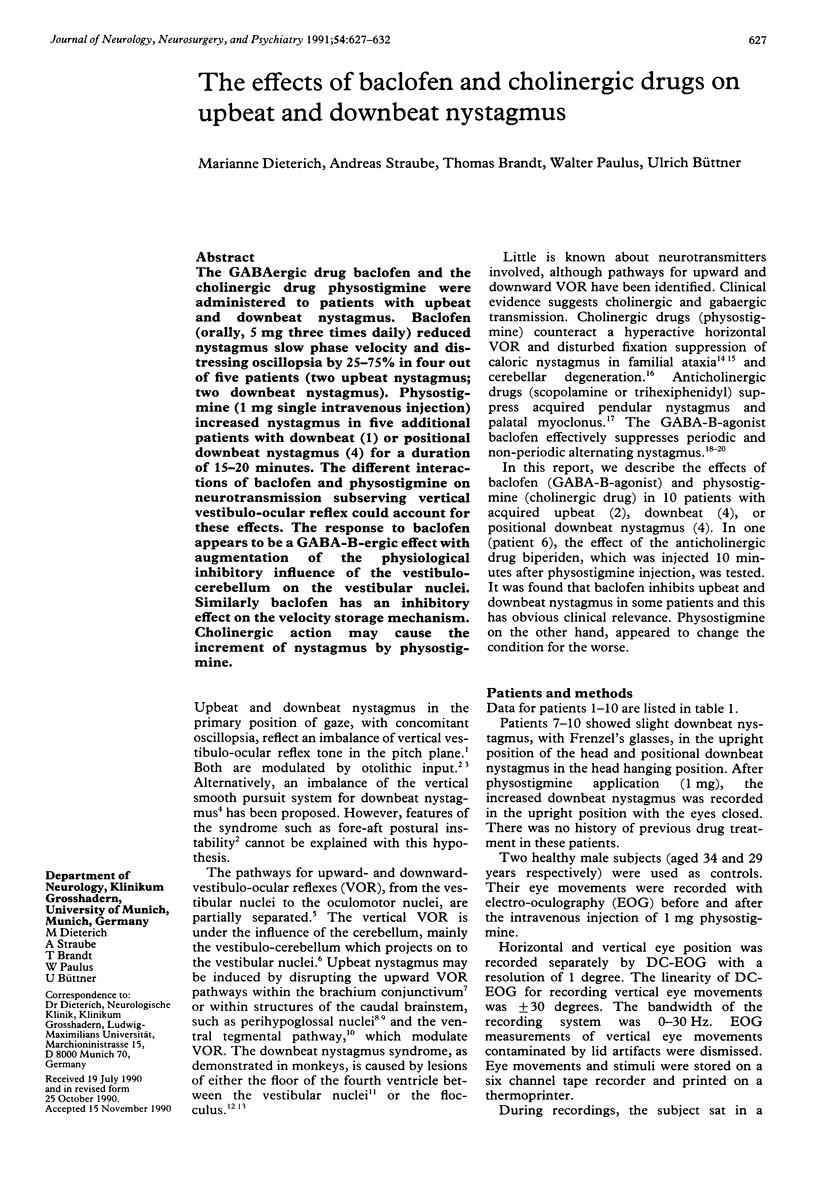
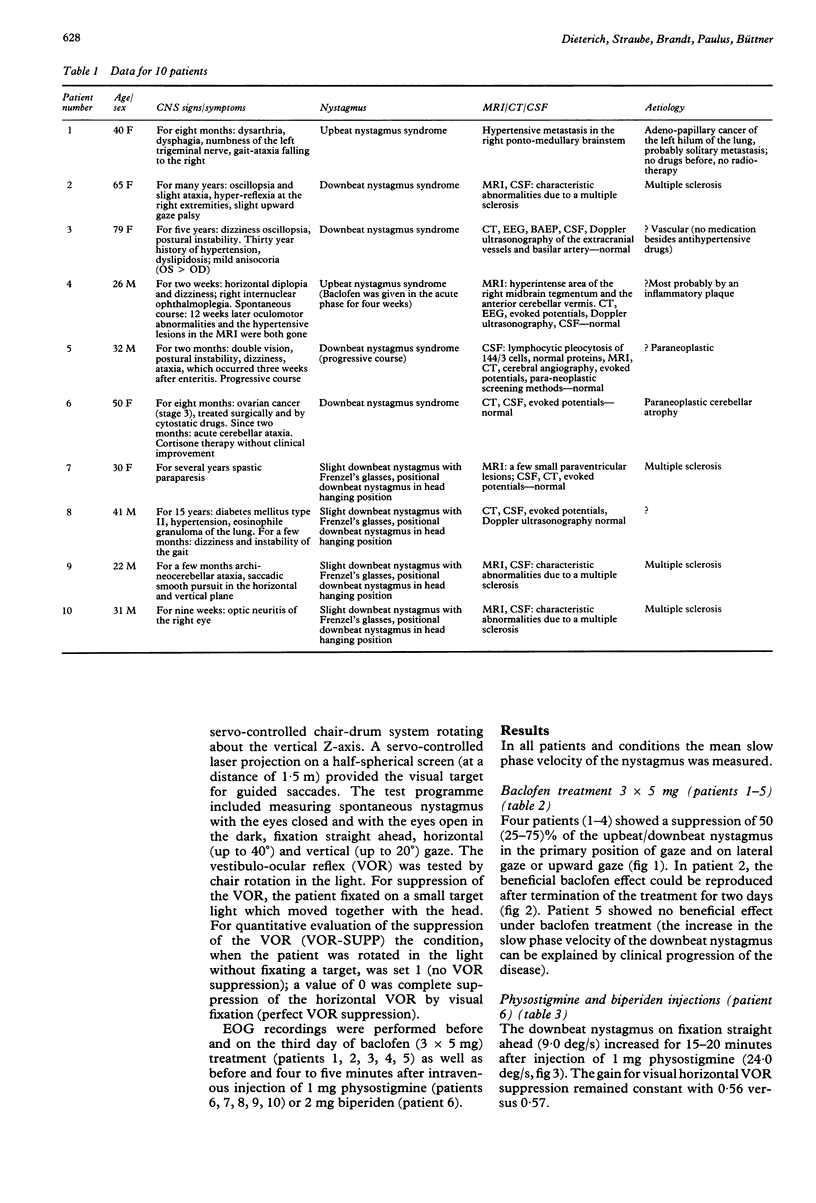
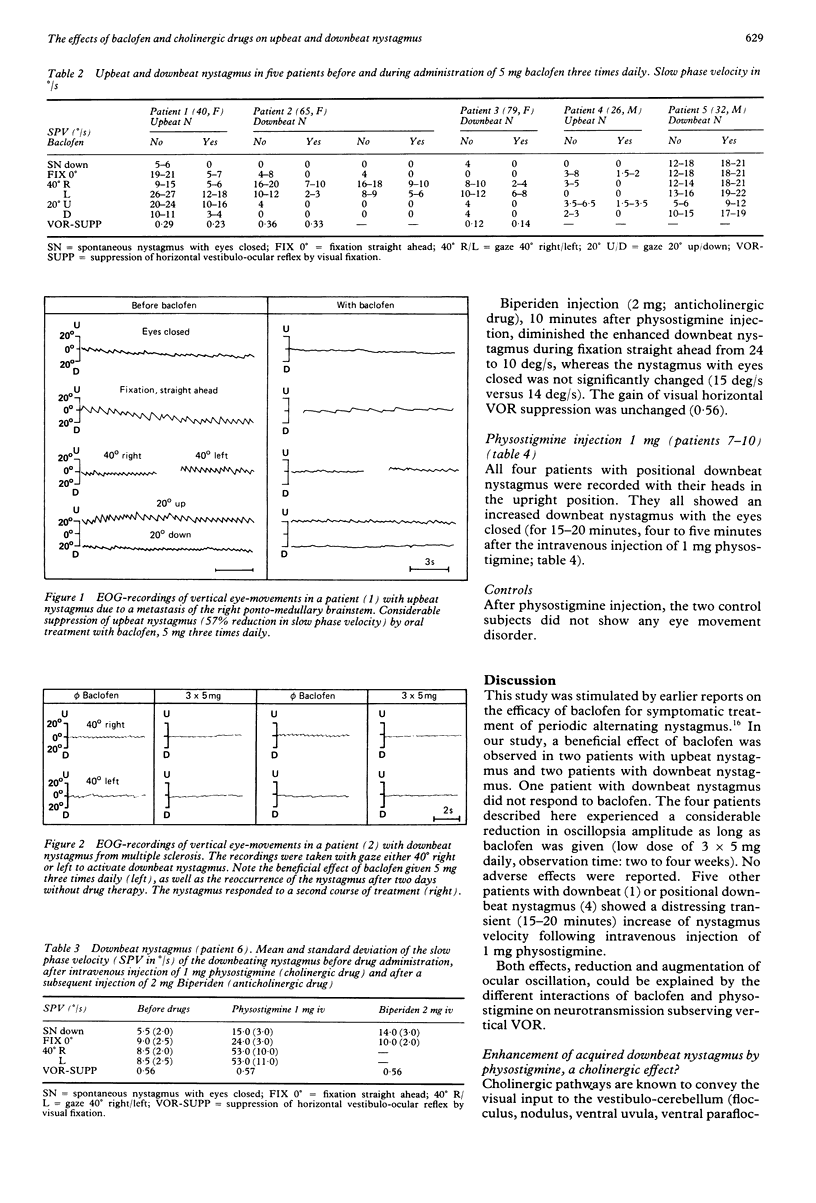
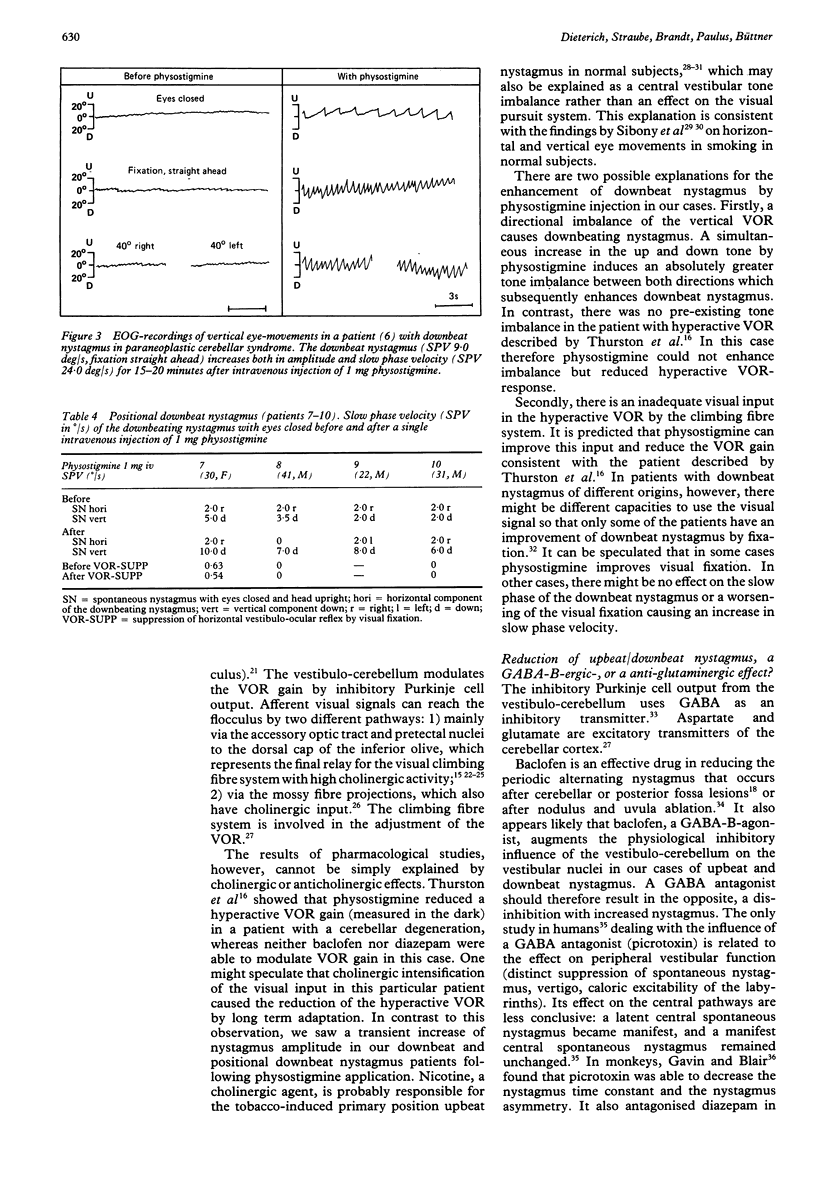
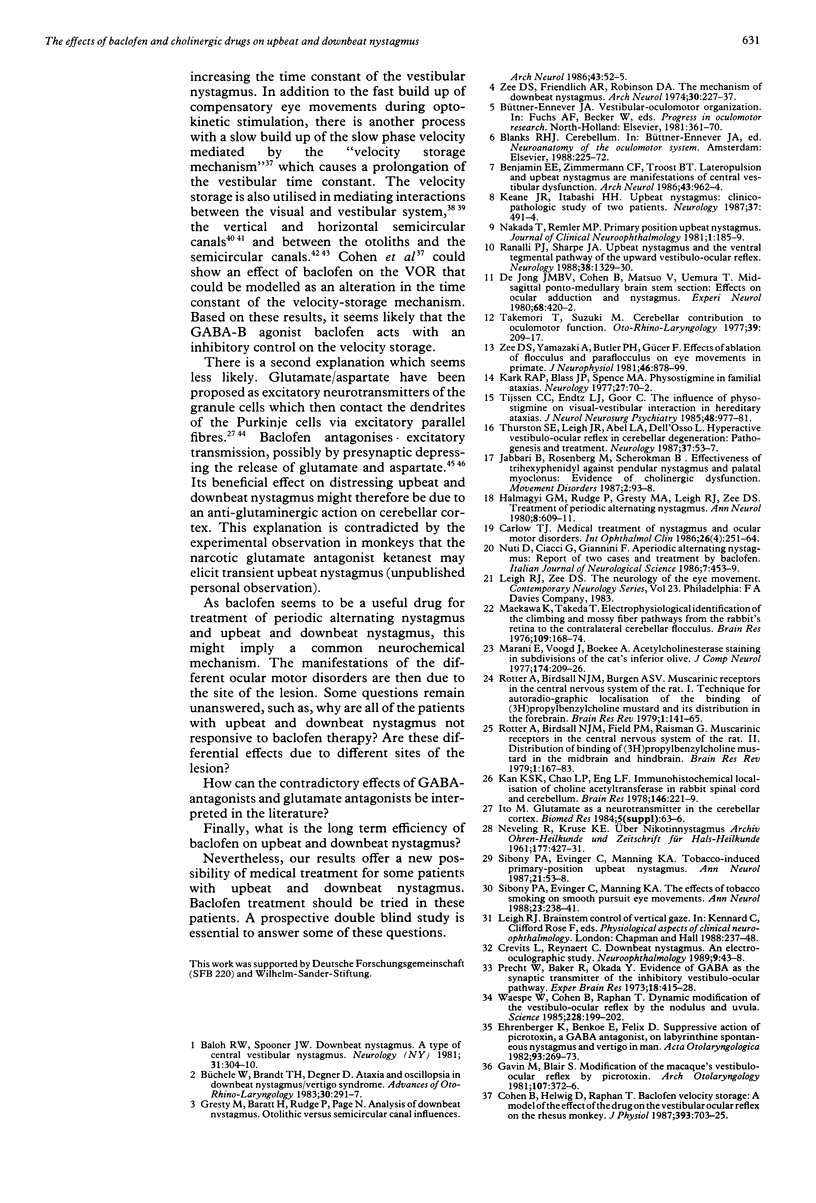
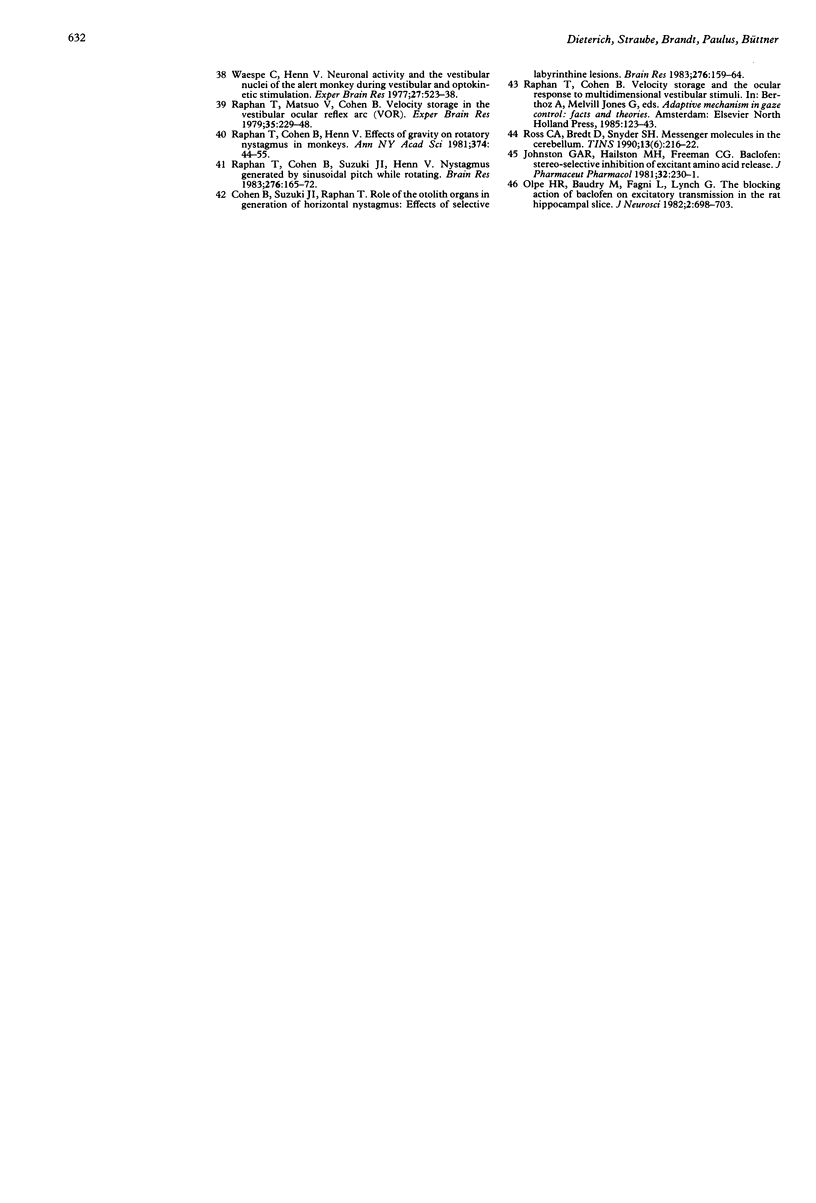
Selected References
These references are in PubMed. This may not be the complete list of references from this article.
- Baloh R. W., Spooner J. W. Downbeat nystagmus: a type of central vestibular nystagmus. Neurology. 1981 Mar;31(3):304–310. doi: 10.1212/wnl.31.3.304. [DOI] [PubMed] [Google Scholar]
- Benjamin E. E., Zimmerman C. F., Troost B. T. Lateropulsion and upbeat nystagmus are manifestations of central vestibular dysfunction. Arch Neurol. 1986 Sep;43(9):962–964. doi: 10.1001/archneur.1986.00520090086025. [DOI] [PubMed] [Google Scholar]
- Büchele W., Brandt T., Degner D. Ataxia and oscillopsia in downbeat-nystagmus vertigo syndrome. Adv Otorhinolaryngol. 1983;30:291–297. doi: 10.1159/000407661. [DOI] [PubMed] [Google Scholar]
- Carlow T. J. Medical treatment of nystagmus and ocular motor disorders. Int Ophthalmol Clin. 1986 Winter;26(4):251–264. doi: 10.1097/00004397-198602640-00022. [DOI] [PubMed] [Google Scholar]
- Cohen B., Helwig D., Raphan T. Baclofen and velocity storage: a model of the effects of the drug on the vestibulo-ocular reflex in the rhesus monkey. J Physiol. 1987 Dec;393:703–725. doi: 10.1113/jphysiol.1987.sp016849. [DOI] [PMC free article] [PubMed] [Google Scholar]
- Cohen B., Suzuki J. I., Raphan T. Role of the otolith organs in generation of horizontal nystagmus: effects of selective labyrinthine lesions. Brain Res. 1983 Oct 3;276(1):159–164. doi: 10.1016/0006-8993(83)90558-9. [DOI] [PubMed] [Google Scholar]
- Ehrenberger K., Benkoe E., Felix D. Suppressive action of picrotoxin, a GABA antagonist, on labyrinthine spontaneous nystagmus and vertigo in man. Acta Otolaryngol. 1982;93(1-6):269–273. doi: 10.3109/00016488209130882. [DOI] [PubMed] [Google Scholar]
- Gavin M., Blair S. Modification of the macaque's vestibulo-ocular reflex by picrotoxin. Arch Otolaryngol. 1981 Jun;107(6):372–376. doi: 10.1001/archotol.1981.00790420046010. [DOI] [PubMed] [Google Scholar]
- Gresty M., Barratt H., Rudge P., Page N. Analysis of downbeat nystagmus. Otolithic vs semicircular canal influences. Arch Neurol. 1986 Jan;43(1):52–55. doi: 10.1001/archneur.1986.00520010048021. [DOI] [PubMed] [Google Scholar]
- Halmagyi G. M., Rudge P., Gresty M. A., Leigh R. J., Zee D. S. Treatment of periodic alternating nystagmus. Ann Neurol. 1980 Dec;8(6):609–611. doi: 10.1002/ana.410080611. [DOI] [PubMed] [Google Scholar]
- Jabbari B., Rosenberg M., Scherokman B., Gunderson C. H., McBurney J. W., McClintock W. Effectiveness of trihexyphenidyl against pendular nystagmus and palatal myoclonus: evidence of cholinergic dysfunction. Mov Disord. 1987;2(2):93–98. doi: 10.1002/mds.870020202. [DOI] [PubMed] [Google Scholar]
- Johnston G. A., Hailstone M. H., Freeman C. G. Baclofen: stereoselective inhibition of excitant amino acid release. J Pharm Pharmacol. 1980 Mar;32(3):230–231. doi: 10.1111/j.2042-7158.1980.tb12902.x. [DOI] [PubMed] [Google Scholar]
- Kan K. S., Chao L. P., Eng L. F. Immunohistochemical localization of choline acetyltransferase in rabbit spinal cord and cerebellum. Brain Res. 1978 May 12;146(2):221–229. doi: 10.1016/0006-8993(78)90970-8. [DOI] [PubMed] [Google Scholar]
- Kark R. A., Blass J. P., Spence M. A. Physostigmine in familial ataxias. Neurology. 1977 Jan;27(1):70–72. doi: 10.1212/wnl.27.1.70. [DOI] [PubMed] [Google Scholar]
- Keane J. R., Itabashi H. H. Upbeat nystagmus: clinicopathologic study of two patients. Neurology. 1987 Mar;37(3):491–494. doi: 10.1212/wnl.37.3.491. [DOI] [PubMed] [Google Scholar]
- Marani E., Voogd J., Boekee A. Acetylcholinesterase staining in subdivisions of the cat's inferior olive. J Comp Neurol. 1977 Jul 15;174(2):209–226. doi: 10.1002/cne.901740203. [DOI] [PubMed] [Google Scholar]
- Nakada T., Remler M. P. Primary position upbeat nystagmus. Another central vestibular nystagmus? J Clin Neuroophthalmol. 1981 Sep;1(3):185–189. doi: 10.3109/01658108109004917. [DOI] [PubMed] [Google Scholar]
- Nuti D., Ciacci G., Giannini F., Rossi A., Federico A. Aperiodic alternating nystagmus: report of two cases and treatment by baclofen. Ital J Neurol Sci. 1986 Aug;7(4):453–459. doi: 10.1007/BF02283025. [DOI] [PubMed] [Google Scholar]
- Olpe H. R., Baudry M., Fagni L., Lynch G. The blocking action of baclofen on excitatory transmission in the rat hippocampal slice. J Neurosci. 1982 Jun;2(6):698–703. doi: 10.1523/JNEUROSCI.02-06-00698.1982. [DOI] [PMC free article] [PubMed] [Google Scholar]
- Precht W., Baker R., Okada Y. Evidence for GABA as the synaptic transmitter of the inhibitory vestibulo-ocular pathway. Exp Brain Res. 1973 Nov 29;18(4):415–428. doi: 10.1007/BF00239109. [DOI] [PubMed] [Google Scholar]
- Ranalli P. J., Sharpe J. A. Upbeat nystagmus and the ventral tegmental pathway of the upward vestibulo-ocular reflex. Neurology. 1988 Aug;38(8):1329–1330. doi: 10.1212/wnl.38.8.1329. [DOI] [PubMed] [Google Scholar]
- Raphan T., Cohen B., Henn V. Effects of gravity on rotatory nystagmus in monkeys. Ann N Y Acad Sci. 1981;374:44–55. doi: 10.1111/j.1749-6632.1981.tb30859.x. [DOI] [PubMed] [Google Scholar]
- Raphan T., Cohen B., Suzuki J., Henn V. Nystagmus generated by sinusoidal pitch while rotating. Brain Res. 1983 Oct 3;276(1):165–172. doi: 10.1016/0006-8993(83)90559-0. [DOI] [PubMed] [Google Scholar]
- Raphan T., Matsuo V., Cohen B. Velocity storage in the vestibulo-ocular reflex arc (VOR). Exp Brain Res. 1979 Apr 2;35(2):229–248. doi: 10.1007/BF00236613. [DOI] [PubMed] [Google Scholar]
- Ross C. A., Bredt D., Snyder S. H. Messenger molecules in the cerebellum. Trends Neurosci. 1990 Jun;13(6):216–222. doi: 10.1016/0166-2236(90)90163-5. [DOI] [PubMed] [Google Scholar]
- Rotter A., Birdsall N. J., Burgen A. S., Field P. M., Hulme E. C., Raisman G. Muscarinic receptors in the central nervous system of the rat. I. Technique for autoradiographic localization of the binding of [3H]propylbenzilylcholine mustard and its distribution in the forebrain. Brain Res. 1979;180(2):141–165. doi: 10.1016/0165-0173(79)90002-x. [DOI] [PubMed] [Google Scholar]
- Rotter A., Birdsall N. J., Field P. M., Raisman G. Muscarinic receptors in the central nervous system of the rat. II. Distribution of binding of [3H]propylbenzilylcholine mustard in the midbrain and hindbrain. Brain Res. 1979;180(2):167–183. doi: 10.1016/0165-0173(79)90003-1. [DOI] [PubMed] [Google Scholar]
- Sibony P. A., Evinger C., Manning K. A. The effects of tobacco smoking on smooth pursuit eye movements. Ann Neurol. 1988 Mar;23(3):238–241. doi: 10.1002/ana.410230305. [DOI] [PubMed] [Google Scholar]
- Sibony P. A., Evinger C., Manning K. A. Tobacco-induced primary-position upbeat nystagmus. Ann Neurol. 1987 Jan;21(1):53–58. doi: 10.1002/ana.410210110. [DOI] [PubMed] [Google Scholar]
- Takemori S., Suzuki M. Cerebellar contribution to oculomotor function. ORL J Otorhinolaryngol Relat Spec. 1977;39(4):209–217. doi: 10.1159/000275359. [DOI] [PubMed] [Google Scholar]
- Tijssen C. C., Endtz L. J., Goor C. The influence of physostigmine on visual-vestibular interaction in hereditary ataxias. J Neurol Neurosurg Psychiatry. 1985 Oct;48(10):977–981. doi: 10.1136/jnnp.48.10.977. [DOI] [PMC free article] [PubMed] [Google Scholar]
- Waespe W., Cohen B., Raphan T. Dynamic modification of the vestibulo-ocular reflex by the nodulus and uvula. Science. 1985 Apr 12;228(4696):199–202. doi: 10.1126/science.3871968. [DOI] [PubMed] [Google Scholar]
- Waespe W., Henn V. Neuronal activity in the vestibular nuclei of the alert monkey during vestibular and optokinetic stimulation. Exp Brain Res. 1977 Apr 21;27(5):523–538. doi: 10.1007/BF00239041. [DOI] [PubMed] [Google Scholar]
- Zee D. S., Friendlich A. R., Robinson D. A. The mechanism of downbeat nystagmus. Arch Neurol. 1974 Mar;30(3):227–237. doi: 10.1001/archneur.1974.00490330035006. [DOI] [PubMed] [Google Scholar]
- Zee D. S., Yamazaki A., Butler P. H., Gücer G. Effects of ablation of flocculus and paraflocculus of eye movements in primate. J Neurophysiol. 1981 Oct;46(4):878–899. doi: 10.1152/jn.1981.46.4.878. [DOI] [PubMed] [Google Scholar]
- de Jong J. M., Cohen B., Matsuo V., Uemura T. Midsagittal pontomedullary brain stem section: effects on ocular adduction and nystagmus. Exp Neurol. 1980 Jun;68(3):420–442. doi: 10.1016/0014-4886(80)90098-9. [DOI] [PubMed] [Google Scholar]


